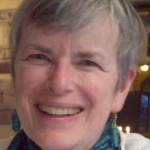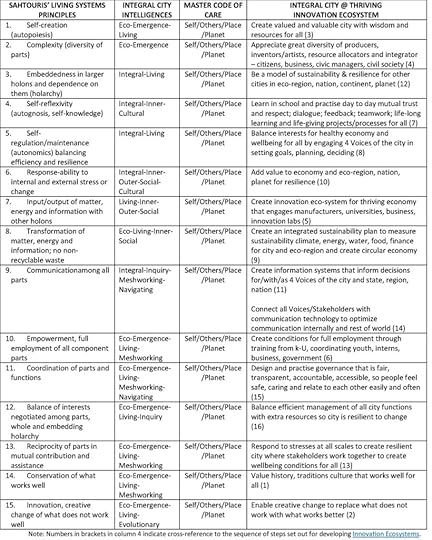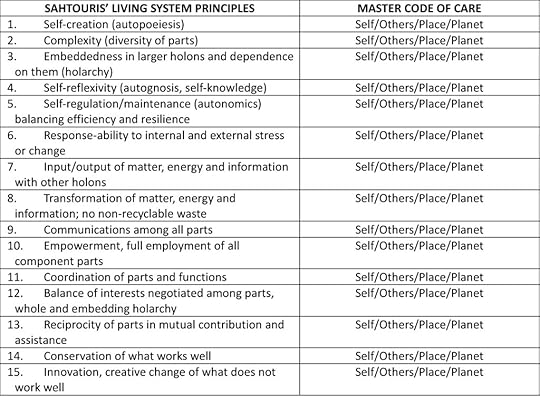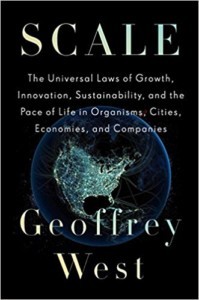Marilyn Hamilton's Blog, page 45
September 13, 2017
Integral City Community Practise Placecaring and Placemaking
Our Integral City Core Team, Community of Practice (COP) has been convening Zoom conference calls about once per month for five years now. In between calls we are in frequent email exchange about our various projects and interests. After the recent publication of Book 2, the theme of “place” was provoked by Cherie Beck, sharing how she was exploring Washington DC as a “world city”. She remarked on the potency of her visit to the Washington Monument (the obelisk that so often symbolizes the city) – how she could sense the Spirit of the City of Washington DC in this place.

This conversation has since sparked action, inquiry and reflection on the topic of “place” in our COP. Our cogitations in turn, reminded me of an important footnote to Book 2 (Integral City Inquiry & Action: Designing Impact for the Human Hive, p.xxvii). Ian Wight had remarked that we should,
“consider a place/Place/PLACE differentiation similar to [Mark DeKay’s] nature/Nature/NATURE elucidation. [We should Move beyond] locating ‘place’ in just the physiosphere and/or the biosphere … locating ‘Place’ as – additionally – in the noosphere … thinking of PLACE as all quadrants, all levels (including the theosphere? (see p. 327 in DeKay’s Integral Sustainable Design). … similarly situate/differentiate your sense of city/City/CITY … There are other integral interpretations of place and placemaking for folks who might want to explore these, if/when their integral appetites have been whetted. … these interpretations strive for even greater, more expansive, notions of wholeness… city/City/CITY wholeness in your case [the whole-making, at the core of both placemaking and wellbeing for myself, is the terrain around which we both might eventually find common ground].”
As a result, of our online discussion and the comments seeded by Ian, we share the following series of Blogs exploring the many phenomena of place, Place and PLACE. I think the Guest Bloggers contribute perspectives about Placecaring and Placemaking from all 4 quadrants – subjective, intersubjective, objective and interobjective.
And yet, I don’t think we could say our exploration is by any means exhaustive, or even definitive – but rather conveys a delicious titillation through all our senses of discovery, play and amazement in the arts of Placecaring and Placemaking.
This blog series continues a celebration of the launch of Book 2 in the Integral City Book Series: Integral City Inquiry & Action: Designing Impact for the Human Hive.
In this blog series, Guest Bloggers from the Integral City Community of Practice explore how each is living the practices of Placecaring & Placemaking.
The series includes:
Integral City Community Practise Placecaring and Placemaking
An Intuitive Walk Through Amsterdam
How is Your City Your Habitat?
Post Script: Sorting into Birth Order as Right Place
August 30, 2017
Cohering: Principles of Living Systems, Intelligences, Master Code, Innovation Ecosystems
Practising the Principles of Living Systems with intention and attention in/with/as the Integral City reveals that they offer guidance for defining, strategizing and learning the lessons of sustainability and resilience in ways we still struggle to achieve.

But translating the Principles into the injunctions of the Master Code produces the holarchy of expanding circles of compassion and CARE that in turn generates the Integral City Intelligences that we need to live sustainably and with resilience that respects all life. This Integral Practise will in turn enable the development of Integral Cities as innovation ecosystems because we practise the Master Code of Care in service to LIFE.
The great reward is that by honoring the Principles of Living Systems, we create the conditions for an evolutionary emergence that not only generates but coheres Integral City Intelligences with the Master Code of CARE and the strategies for creating thriving sustainable and resilient Innovation Ecosystems. It is a beautiful meshwork of human systems at the city scale – summarized in the table below.
In this blog series examining Sahtouris’ Principles of Livings Systems, we:
outline the Principles of Living Systems
propose a sequence of activities that cities can undertake to create Innovation Ecosystems
consider the Integral City Intelligences that emerge from the Principles
recognize the roots of the Principles in the Master Code of Caring
align the Principles, Intelligences, Master Code and Activities for Innovation Ecosystems
August 29, 2017
Master Code of CARE Arises from Living Systems Principles
The Master Code of CARE that lies at the heart of Integral City evolution arises from the Living Systems Principles shared by evolution biologist Elisabet Sahtouris.

The paradox in Elisabet’s Principles is that they are not only biological, but are founded in the assumption that the universe is conscious. That means that the Living Systems Principles derive both from biology and consciousness. Furthermore, the potent combination calls forth and co-creates the collective capacities of systems and culture. Thus, we reveal the realities underlying the 4 Quadrant framework of Integral City (often called bio-psycho-social-cultural).
As noted in our earlier blog, the Living Systems Principles recognize the holarchic nature of the different holons embedded in a system. In human systems, they include not only individual holons, but also the social holons, that embrace all the collectives that co-exist in the city at different scales.
The Integral City Master Code is a synthesis of all the Living System Principles into 4 key injunctions:
Care for your SELF (so that you can)
Care for OTHERS (so that all of us can)
Care for our PLACES (so that together we can)
Care for our PLANET.
Each of the Principles of Living Systems when applied at the scale of the city, appears to embrace all 4 statements of the Master Code. And we propose, even that the Integral City Master Code calls forth a 4-part practise that is essentially spiritual.
Moreover, practising all 4 parts simultaneously has become possible to accomplish for the first time in history because of the stage of evolution human systems have emerged in communities, organizations, technology and communication. That means that each level of CARE builds the Context and Capacity to enable CARE at the next scale.
If we want to know how to practise the CARE that we seek to live with this Master Code, we need only pay attention to the Principles of Living Systems. They provide us both the course for life to follow, and the directions for “course correction”.
In this blog series examining Sahtouris’ Principles of Livings Systems, we:
outline the Principles of Living Systems
propose a sequence of activities that cities can undertake to create Innovation Ecosystems
consider the Integral City Intelligences that emerge from the Principles
recognize the roots of the Principles in the Master Code of Caring
align the Principles, Intelligences, Master Code and Activities for Innovation Ecosystems
August 28, 2017
Integral City Intelligences Reflect Living System Principles
The 12 Intelligences of the Integral City can be directly connected to the Principles of Living Systems. This may not be surprising given the core influences of their creators. In the case of the 12 Intelligences, I was considering the evolution of the holarchy of human systems from individual, to family/collectives, to organizations, to the City. In the case of Elisabet Sahtouris, she was considering the evolution of the (conscious) biology of living systems. Thus, given that human systems are living systems, we should expect that the taxonomies of the Intelligences and the Principles should reflect one another.

Integral City Intelligences, framed at the human systems scale of the City represent its core capacities derived from the first Principles of Living Systems.
Moreover, if we want to understand why and how it is possible for a City to thrive as a living innovation ecosystem (discussed in the first two blogs of this series), we can backcast to the capacities of intelligences that the City would require in order to design, organize and manifest such a system.
We have given full definitions of the Integral City Intelligences in Book 1 (Integral City: Evolutionary Intelligences for the Human Hive) and on the website. Here we link them to Elisabet Sahtouris’ Principles of Living Systems, so we can reveal their qualities of aliveness. In many cases one of the Principles manifests in multiple Integral City intelligences because of their holographic, interconnected and even non-local nature.
Let’s take another walk through Sahtouris’ Principles of Living Systems and connect them to the brief definitions of Integral City Intelligences that are set out below the Principles.
Principle 1: Self-creation (autopoiesis) is reflected in the Eco, Emergent and Living Intelligences.
Principle 2: Complexity (diversity of parts) is reflected in Eco and Emergent Intelligences.
Principle 3: Embeddedness in larger holons and dependence on them (holarchy) is reflected in Integral and Living Intelligences.
Principle 4: Self-reflexivity (autognosis, self-knowledge) is reflected in Integral, Inner and Storytelling/Cultural Intelligences.
Principle 5: Self-regulation/maintenance (autonomics) balancing efficiency and resilience is reflected in Integral and Living Intelligences.
Principle 6: Response-ability to internal and external stress or change is reflected in Individual (Integral Inner, Outer), and Collective (Social/Building and Cultural/Storytelling) Intelligences.
Principle 7: Input/output of matter, energy and information with other holons is reflected in Living, Inner and Social/Building Intelligences.
Principle 8: Transformation of matter, energy and information; no non-recyclable waste is reflected in Living, Inner and Social/Building Intelligences.
Principle 9: Communications among all parts is reflected in Integral, Inquiry, Meshworking and Navigating Intelligences.
Principle 10: Empowerment, full employment of all component parts is reflected in Eco, Emergent, Living and Meshworking Intelligences.
Principle 11: Coordination of parts and functions is reflected in Eco, Emergent, Living, Meshworking and Navigating Intelligences.
Principle 12: Balance of interests negotiated among parts, whole and embedding holarchy is reflected in Eco, Emergent, Living and Inquiry Intelligences.
Principle 13: Reciprocity of parts in mutual contribution and assistance is reflected in Eco, Emergent, Living and Meshworking Intelligences.
Principle 14: Conservation of what works well is reflected in Eco, Emergent, Living and Meshworking Intelligences.
Principle 15: Innovation, creative change of what does not work well is Eco, Emergent, Living and Evolutionary Intelligences.
Integral City Definitions of the 12 Intelligences
Contexting Intelligences
Eco
Ecosphere intelligence is an awareness and capacity to respond to the realities of a city’s climate and eco-region environment.
Emergent
Emergent intelligence looks at the city as a whole, through the lenses of, aliveness, survival, adaptiveness, regeneration, sustainability and emergence.
Integral
Integral intelligence uses four essential maps of city life to see the whole city.
Living
Living intelligence relates to the aliveness of each citizen through each of its lifecycle stages and the aliveness of the city through its lifecycle stages.
Individual Intelligences
Inner
Inner intelligence is ‘I’ space of the citizen – the seat of intentional consciousness, attention, interior experience and lines of development.
Outer
Outer intelligence is the biological ‘it’ space of the citizen- the space where the body acts and behaves.
Collective Intelligences
Social
Social intelligence is the ‘its’ space of the city that gives us the capacity, to structure and systemize our environment.
Cultural
Cultural intelligence represents the ‘we’ life of the city-the relationships in the city which transcend boundaries that both contain and separate.
Strategic Intelligences
Inquiry
Inquiry intelligence asks key questions that reveal the meta-wisdom of the city.
Meshworking
Meshworking intelligence attracts the best of two operating systems- one that self-organizes, and the other that replicates hierarchal structures – to align systems that flex and flow.
Navigating
Navigating intelligence monitors and discloses the wellbeing or general condition of the city.
Evolutionary Intelligences
Evo
Evolutionary intelligence is the capacity to transcend and include the intelligences, we currently demonstrate, in order to allow new intelligences to emerge.
In this blog series examining Sahtouris’ Principles of Livings Systems, we:
outline the Principles of Living Systems
propose a sequence of activities that cities can undertake to create innovation ecosystems
compare the Principles and Activities
consider the Integral City Intelligences that emerge from the Principles; and
consider the roots of the Principles in the Master Code of Caring
August 27, 2017
Renewal Steps to Creating City as Thriving, Innovation Ecosystem
Cities that thrive operate as living systems designed for wellbeing as innovation ecosystems. Book 2 in our Integral City series outlines processes to achieve innovation and wellbeing impact through Placecaring and Placemaking in the ecosystem of the city.

Those processes are grounded in Elisabet Sahtouris’ Principles of Living Systems. They give us a checklist to review the design guide that aligns how we “retrofit” our cities so that they operate with these Living Principles. The Principles enable Placecaring and Placemaking to emerge – but usually in a different sequence than the Principles are set out, because cities with a history and culture require the sequence of steps to make change possible to the existing systems.
We suggest a natural sequence for renewing the city involves the key steps of: Discovery, Strategic Planning, Contexting Sustainability & Resilience, Connecting & Communicating and Governing. Review your city’s approaches to Placecaring and Placemaking with the steps set out below (with number links to the Principles of Living Systems from the previous blog) and use the Action Research approaches in Book 2 to engage the 4+1 Voices to bring your city to life.
Discovery
Value history, traditions culture that works well for all (14)
Enable creative change to replace what does not work with what works better (15)
Create valued and valuable city Vision with wisdom and resources for all (1)
Appreciate great diversity of producers, inventors/artists, resource allocators and integrator – citizens, business, civic managers, civil society (2)
Strategic Plan
Create innovation eco-system for thriving economy that engages manufacturers, universities, business, innovation labs (7)
Create conditions for full employment through training from k-U, coordinating youth, interns, business, government (10)
Learn in school and practise day to day mutual trust and respect; dialogue; feedback; teamwork; life-long learning and life-giving projects/processes for all (4)
Balance interests for healthy economy and wellbeing for all by engaging 4 Voices of the city in setting goals, planning, deciding (5)
Context Sustainability & Resilience
Create an integrated sustainability plan to measure sustainability climate, energy, water, food, finance for city and eco-region and create circular economy (8)
Add value to economy and eco-region, nation, planet for resilience (6)
Create information systems that inform decisions for/with/as 4 Voices of the city and state, region, nation (9)
Be a model of sustainability & resilience for other cities in eco-region, nation, continent, planet (3)
Respond to stresses at all scales to create resilient city where stakeholders work together to create wellbeing conditions for all (13)
Connect & Communicate
Connect all Voices/Stakeholders with communication technology to optimize communication internally and rest of world (9)
Govern
Design and practise governance that is fair, transparent, accountable, accessible, so people feel safe, caring and relate to each other easily and often (11)
Balance efficient management of all city functions with extra resources so city is resilient to change (12)
In this blog series examining Sahtouris’ Principles of Livings Systems, we:
outline the Principles of Living Systems
propose a sequence of activities that cities can undertake to create innovation ecosystems
compare the Principles and Activities
consider the roots of the Principles in the Master Code of Caring; and
consider the Integral City Intelligences that emerge from the Principles.
August 26, 2017
Living System Principles for Integral City Innovation Ecosystems
Dr. Elisabet Sahtouris, evolution biologist, has long been an inspiration to me and the framing of Integral City Intelligences, Voices, Inquiry and Action in Book 2 and Book 1.
One of our initial mutual attractions was how we share a metaphor about living systems from 2 different but related perspectives. Elisabet describes the living cell using the metaphor of a city, and I describe a city with the metaphor of a living cell.

In both cases, we are drawing on our understanding and appreciation of living systems and the principles that they use to function. As I prepare for several presentations and workshops in the months ahead, I have returned to Elisabet’s Principles to renew my recommendations for designing an Integral City as an innovation ecosystem. Let’s walk through those Principles and see how they would translate into strategic intentions and activities. In reviewing these Principles of life at the microscopic level of the cell, we look for the similar pattern at the macroscopic scale of the city as a living system (keeping in mind how the 4+1 Voices of the City cooperate and collaborate to bring the City to life).
Principle 1: Self-creation (autopoiesis) means that a city would need to create a habitat for people that respected the wisdom and resources of its people in relationship to the ecological, geological and biological life conditions of its location and climate.
Principle 2: Complexity (diversity of parts) means that a city would optimize the functioning of its parts by appreciating and supporting the diversity of its 4 Voices – so that citizens (Producers), business/inventors (Diversity Generators), civic managers (Resource Allocators) and civil society (Integrators) can work differently together to achieve a shared Vision.
Principle 3: Embeddedness in larger holons and dependence on them (holarchy) means that a city would be a model of sustainability and resilience as it recognized that it was part of the larger system of human and other living systems contained in the eco-region, nation, continent and planet.
Principle 4: Self-reflexivity (autognosis, self-knowledge) requires the city as a systems of systems, along with its collective groups (organizations, associations, neighbourhoods, teams, families) and individuals are enabled and encouraged to be lifelong learners. This type and attitude to learning starts with the practise of mutual trust and respect. It depends on regular reflective dialogue, feedback and working towards life-giving projects for all.
Principle 5: Self-regulation/maintenance (autonomics) balancing efficiency and resilience is the city-wide practise of managing resources, goals, plans and decisions so the economy is healthy and everyone experiences wellbeing. Self-regulation is a form of practical governance that engages all 4 Voices of the city.
Principle 6: Response-ability to internal and external stress or change requires the 4 Voices of the city to share information openly and take decisions related to resolving their internal tensions and also to pay attention to the 5th Voice of the City represented by other cities in the eco-region. Responding to stresses in a healthy way enables resilience and response-able change.
Principle 7: Input/output of matter, energy and information with other holons means that the city creates an innovation eco-system that recognizes all 4 Voices (and cities in other eco-regions) and their institutions (especially infrastructures, manufacturers, food producers, schools/universities, business, innovation labs and health systems) are aligned into a circular economy that supports equitable access to matter, energy and information for all.
Principle 8: Transformation of matter, energy and information; no non-recyclable waste means sharing and tracking the matter, energy and information flows (governed by Principle 7) so that all output from one holon or function is input for another holon or function and no waste results. This is tracked by an integrated sustainability plan that tracks the vital signs of life for all holons/functions.
Principle 9: Communications among all parts requires that cities create information systems that connect all Voices/Stakeholders with technology to optimize and inform decisions for/with/as the 4 Voices of the city (and state, region, nation, world).
Principle 10: Empowerment, full employment of all component parts tasks the city with creating education and training from K-U to create the conditions for full employment, that coordinates students, interns, business and government and supports the economy’s innovation ecosystem.
Principle 11: Coordination of parts and functions calls for cities to design and practise governance that is fair, transparent, accountable and accessible so people feel safe, caring and can relate to each other easily and often in the coordination of their living, working, play and learning.
Principle 12: Balance of interests negotiated among parts, whole and embedding holarchy requires that the city and its organizations (serving all 4 Voices) balance efficient management of all functions so they are mutually supportive and resourced for resilience to change (meaning parts serve whole, and whole serves parts and together they serve the holarchy of human systems in the city).
Principle 13: Reciprocity of parts in mutual contribution and assistance asks the city to design and align its sub-systems and functions so that they are mutually supportive and able to assist each other when stressed and/or celebrate with one another when goals are achieved.
Principle 14: Conservation of what works well is a basic survival strategy for all human systems in the city – to retain and support that which is life-giving as foundational for adapting to changing life conditions, sustainability, resilience and regeneration.
Principle 15: Innovation, creative change of what does not work well is a corollary to Principle 14 – it is important for cities as innovation ecosystems to identify what is not working, to cease or change the practise and replace it with improvements that work better and/or optimally.
In the next blogs examining Sahtouris’ Principles of Livings Systems, we will re-order these Principles to:
propose a sequence of activities that cities can undertake to create innovation eco-systems
compare the Principles and Activities
consider the roots of the Principles in the Master Code of Caring; and
consider the Integral City Intelligences that emerge from the Principles.
July 30, 2017
Cohering the Integral City We-Space: A Resource for Catalyzing Gaia’s Reflective Organ
Cohering the Integral We-Space: Engaging Collective Emergence, Wisdom & Healing in Groups is a new resource with potential to catalyze the emergence of Integral Cities. The book is an edited volume (by editors Olen Gunnlaugson and Michael Brabant) that reveals the leading edges of We-Space through the lenses of integrally informed practitioners located in the developed world.

Each chapter describes the practice(s) of a distinctive group or community of practice exploring, embodying, experimenting with, or engaging the intersubjective We. As the Founder of Integral City frameworks and author of the Integral City Book series, I can’t help but imagine what would be the effect on the emergence and/or quickening of Integral City capacities (aka intelligences) and practices if all the We-space practices described in the book were alive and active in one (or more) cities.
While each chapter of the book and the community of practice that is activating We-space adds to the understanding and/or definitions of We-space, in order to be effective in an Integral City it would be useful to clarify the myriad of purposes that are engaged. We might start with a taxonomy of naming, framing, claiming and inhabiting the different forms of We-space. Then we could consider how they might impact the different scales of human systems in the city. It would be useful to know what practices cohere a collection of “I’s”, a group of “We’s”, any purposeful organization(s) embracing a We-culture, or on the most complex level, a system of systems of “We-spaces”.
By mapping a taxonomy or matrix of practices, an Integral City might find “red threads” of coherence where We-space practices can expand or amplify the 5 sets of Integral City intelligences: Contexting, Individual, Collective, Strategic and Evolutionary.
Because one of the chapters in Cohering the Integral We-Space is authored by the Integral City Community of Practice, it would make sense to find the ways that other practices might help us achieve intentions that could supplement how we use Systemic Constellation Work to identify the “invisible” energies of the city.
The introduction of Cohering the Integral We-Space lists a series of outcomes that can apparently be analysed for the purposes of amplifying all the Integral City Intelligences (except Contexting) as follows:
Exploring multiple perspectives.
Practising post-personal spiritual authority.
Mapping a participative journey shared by individuals.
Expand self-hood through collective experience.
Share intimacy of unity amidst diversity.
Collective (Cultural and Social)
Amplifying the we through creating a group container for collective transformations.
Experiencing group phenomenology as an epistemology of knowing about/with/as the city.
Exploring a social basis for shared community.
Discovering group fields of consciousness.
Skilfully engage with groups.
Learn how collectives develop and impact individuals.
Strategic (Inquiry, Meshworking, Navigating)
Engaging and co-creating city culture collectively.
Practising collective creativity.
Develop the ethos of relational communion and love.
Catalyze intelligence into new culture.
Introduce site for awakening healing, living, thinking together
Evolve group flow (nexus agency).
Experience evolution from the inside out.
With an intention to re-purpose Cohering the Integral We-Space in service to an expansion of We-space capacities for the Integral City, the reader can be inspired to discover inter-chapter connectivity, that takes them beyond simply enjoying each chapter on its own merits and into the territory of synergizing across We-space practices and platforms.
Editors declare that the book is intended to serve “the greater global integral community as a catalyst for broadening and clarifying existing conversations” in order to bring forth new perspectives and critical discernment.
Therefore, for Integral City practitioners who have curiosity and/or experience about We-space, this anthology has the potential to open a hallway of doors that inspire us to consider for the value of developing Integral City capacities: epistemologies for intersubjective research, perspectives for interpreting We-space outcomes and insights into ongoing We-space emergence and development.
Future Integral City researchers could use the chapters to set an agenda to discover how experiences, practices, intentions and maps might achieve a very broad spectrum of We-space programs, projects, activities and impacts.
Building on the diversity of authors, represented in the book – who are all pioneers in the We-space field – Integral City could take advantage of a variety of intentions, languages, reflections, capacities, perspectives and life conditions to explore living, working and co-creating in, with and as We-space in the city.
Building on Integral City Action Research modalities (described Book 2 in the Integral City Book Series: Integral City Inquiry & Action: Designing Impact for the Human Hive), we could build on many chapters in, Cohering the Integral We-Space that also use Action Research to guide Integral City practitioners to collaborate in co-researching the expansion of this epistemology.
Integral City might even wish to explore into a space of virtual reality, beyond the third-person account of a second-person-plural We-space experience to discover and describe the true second-person-plural We-space experience as an evolutionary leading edge of city evolution.
It should be noted that Chapter 7 of Cohering the Integral We-Space, authored by Integral City practitioners was originally written from the AQAL Lower Left (LL) perspective in an attempt to convey the “script” or “voice” of the We-space experience. Although this version was not the one published, the attempt to author the LL version transformed the Community of Integral City Practitioners in a significant way. (For example, it helped us learn first-hand the challenge of the journey from a collection of “I’s to a unity of “We’s” and the power of the “space in between” single “Is”, multiple “I’s” and a coherent “We”.)
Cohering the Integral We-Space is a notable resource for achieving its intention to catalyze discussion and communication about We-space. Because every chapter, in some way, advocates for continued growth and maturing of We-space awareness, thought, practice and culture, it is an open invitation to Integral City’s constellation of practitioners to continue this journey.
The next step for Integral City may be to use this book as an opportunity to clarify our core practices; align with other communities; and improve our process methodologies.
It is clear that anthology editors, Michael Brabant and Olen Gunnlaugson, have created with, Cohering the Integral We-Space not just a valuable contribution that makes Integral City practice of We-space visible, accessible and credible but that they have given us a special opportunity to invite other practitioners to consider how they can contribute to the emergence of the most complex human system yet created.
We are curious if anyone would like to nominate their city to be the site of ongoing research for Cohering an Integral City We-Space in service to Gaia’s Reflective Organ (aka the city or human hive) and Gaia’s Reflective Organ System?
July 13, 2017
July 4, 2017
Engaging Change through Whole-self and Whole-systems Exploration
In this article, Guest Blogger and Integral City Lead Constellator, Diana Claire Douglas provides an overview of Systemic Constellation Work (SCW), an approach that enables stakeholders to effectively engage in systems change. Douglas explores opportunities where SCW can be used to enhance Collective Impact efforts and highlights examples of community change to illustrate this possibility.

After attending Tamarack’s Collective Impact 3.0 conference in May, as a systemic facilitator, coach and consultant, I began to wonder if there might be something I could offer that could be integrated into the processes already used by Tamarack? My answer is yes! I facilitate a process, tool and methodology called Systemic Constellation Work (SCW)1 that offers a way for individuals, organizations, institutions, communities, and cities to experience and engage collectively in systems change.
As a participant and “newbie” to the Collective Impact, the Tamarack Institute and the Ontario Trillium Foundation (OTF), I appreciated learning about the different aspects of the CI framework, making new connections, and participating in small group dialogues. As a facilitator, host and participant of conferences, workshops and retreats for 35 years, I enjoyed feeling into this collective field. Here’s what enlivens me the most:
It’s time for systemic change;
Lifelong learning is a core value;
Imagination and creativity are vital for transformation — including new ways of thinking –as experienced with the introduction to Human-Centred Design); and,
There is an openness to change in this field. OTF (the funders), Tamarack (the manifestors) and CI (the process) are each contributors to the process of making systemic change.
So, what is Systemic Constellation Work (SCW)? It is a systemic approach to design, inquiry, research, mapping, testing, seeing the whole system, leadership development and community building. For example, one of the tools is 4D mapping: the system is mapped in 3D space (a room, a tabletop, on the internet) through the use of markers (people, paper, foam mats). This 3D map becomes a 4D living dimensional map of the system as time, space, direction, movement and (often hidden) dynamics are expressed. The purpose of SCW is to inform the members of the system by showing the relationship between and amongst the elements of the system as well as the system as a whole. The 4D, co-created map shows the system as it is, making it easier to envision possible next steps or resolutions. For example, Integral City Community of Practise has discovered the power of SCW to make visible the invisible dynamics alive in the city. This enables practitioners to align strategies with the histories, cultures, relationships and intentions to release energies leading to impactful resolutions.
SCW involves people bringing their whole selves — gut, heart, spirit as well as intellect — to participate in learning together. It involves tapping into the Knowing Field, which invites participants to engage with not-knowing as well as knowing, and trust that we can access wisdom, intelligence and information way beyond what our intellects allow. It allows us to access the emerging future as well as the emerging past.
In sharing a desire to offer ways to create healthy, dynamic communities within rapidly changing complex environments, Systemic Constellation Work could add value to Tamarack’s community development programs, projects and purposes. Based on our experiences with colleagues such as Integral City Meshworks, here’s (some of) what Systemic Constellation Work offers change-makers:
Engage the issues and questions they have about the theme, their community, their city with their whole selves;
Together be able to see their system as a whole system;
Access the hidden dynamics that may be blocking a pathway forward; and,
Co-design and co-create processes and products that align with visions and values and test the prototypes.
Knowing Field Designs would like to acknowledge Kara Stonehouse and Tucker House in Ottawa for introducing us to Collective Impact and looks forward to sharing Systemic Constellation Work with the members of Tamarack’s learning community.
 LEARN MORE ABOUT DIANA CLAIRE DOUGLAS:
LEARN MORE ABOUT DIANA CLAIRE DOUGLAS:
See Diana Claire Douglas as a member Integral City Corps Team here
Contact Diana Claire Douglas via email at: dianaclairedouglas@bell.net;
Visit Diana’s website, Knowing Field Designs: Aligning Human Systems with Life here
View Integral City’s Report for an example of the process and outcomes of Systemic Constellation Work
Click here to find other Collective Impact 3.0 resources
June 27, 2017
Integral City Reflective Organ – June Solstice 2017: Optimizing Collective Intelligence, Inquiry & Impact

This newsletter is published quarterly using a cycle of perspectives on the Integral City viewed from: Planet, People, Place and Power. The theme of this issue is People.
Human social structures create energetic fields whose effects can be measured. At the moment, those measures are rather primitive—for example, we can measure the increase in the heat of a room when large groups are gathered. We can measure how people vote when they are hooked up to a voting machine. We can even measure statistical significance in objective outcomes from seemingly intersubjective effects of staring at a distance or of healing prayer directed by many to a single person. As our instruments and understanding improve, we will come to see that biophysical proximity creates conditions for collective epistemologies (ways of knowing) that are only just now being researched methodically. As our instruments and our understanding complexify, we will be able to measure not only time span of work roles, but mind-span of intentions, and we will understand how to structure social forms to optimize such ways of knowing and how to design built structures to amplify them. (See sidebar on Biological Mimicry for examples on p.156.)
Hamilton, M. (2008). Integral City: Evolutionary Intelligences for the Human Hive. Gabriola Island BC: New Society Publishers, p.158
How Do Integral City Intelligences, Inquiries & Actions Optimize Collective Impact?
In this 2017 newsletter we remember How to Optimize Integral Practise while we point to significant gatherings that offer bright lights, re-frames and tools for surviving VUCA and even measuring progress!!
VUCA was the theme of 2016’s people-focused Newsletter. We suggested ways to survive, with Integral City approaches, the pervasive sense of Volatility, Uncertainty, Complexity and Ambiguity. Over the last year VUCA has intensified around the world, literally striking through acts of terrorism that take advantage of the convergence of human systems in cities, to make the biggest negative impact possible. In the light of such distressing experiences (designed to create incessant “noise” in the media), it is difficult to find, let alone anchor, positive or optimistic perspectives to counter depression about the human condition.
But in this issue we meet several communities of practise; a researcher of the science of cities; and a growing schedule of events designed as extended learning opportunities. All seem to underscore the indomitable, highly adaptable, evolutionary intelligence that optimizes the human spirit.
 Tamarack Community of Practise Creates Movement for Collective Impact
Tamarack Community of Practise Creates Movement for Collective ImpactTamarack Institute has long taken the lessons of complexity to apply them to improving the conditions of communities. It has even stated one of its driving intentions is to end poverty in Canada. Tamarack is no “feel good” not-for-profit, but one that confronts the dragons of intractable problems with practices, based in complexity and compassion, that demand courage, collaboration and research.
One of its most demanding practices (and collaborations) has been the application of a leadership framework for Collective Impact (originally framed by Kania and Kramer of FSG in 2011) that uses 5 dimensions. The original leadership framework was recognized as Management that set out to collaborate for collective success in communities with a framework of 5 conditions:
A Common Agenda
Shared Measurement
Mutually Reinforcing Activities
Continuous Communication
A Backbone Organization.
After 6 years’ experience in the Collective Impact field, Tamarack (Cabaj, Weaver, 2017) has recently proposed the evolution of its own approach to Collective Impact. In this process, Tamarack leaders have recognized how the evolution of the 5 conditions of Collective Impact have transformed from somewhat fixed standards to conditions that flex and flow.

Conditions of Collective Success
At the Collective Impact 3.0 Conference, held in May 2017, the Tamarack Team and invited faculty explored the 5 conditions with Case Studies, Investor Commentary and key voices of the city. From the diversity of people attending the conference, Tamarack demonstrated how their leadership had evolved from “mere” management to Building a Movement. The movement seemed evidenced by the collaborators participating from a wide geography including distinct communities and cities, from as far afield as Australia, Moncton New Brunswick, Cleveland Ohio, Calgary Alberta, Ottawa Ontario, Durant Oklahoma and Abbotsford BC. Capacity builders from the Tamarack Institute Team shared tables with peers of public and private granting institutions, facilitators and community developers.
Tamarack created the conditions at the conference, for individual tables to explore through Systems Perspectives how to coalesce Community Aspirations around a superordinate goal like creating a community of supports for an “archetypal but specifically named” unemployed worker – e.g. “George”. They went on to align a system of Strategic Learning that can be resourced and deliver results to meet the needs of George and thereby the larger community.
(Integral City would recognize these designs as Navigating, Meshworking and Inquiry Intelligences at work.)
Through Keynotes and Deeper Dive Workshops, the Tamarack Team invited participants to role-play Inclusive Community Engagement and to synthesize the experience of learning together into Containers for Change. (Integral City recognizes the Intelligences of Meshworking, Inquiry and Evolution at play.)
Thus, Tamarack co-created what Integral City might call a Learning Lhabitat. In fact, Integral City’s Marilyn Hamilton presented a workshop at Collective Impact 3.0 to share our methods and experience of working with Durant Oklahoma to achieve Collective Impact over the last 4 years. With Durant Integral City translated the Intelligences of Inquiry, Navigating and Meshworking into Placecaring and Placemaking. We worked with the Imagine Durant not-for-profit organization to collaborate with the 4 Voices of the City to translate Cultural and Structural Intelligences into strategies that will realize a common Vision in the decades ahead. (You can read the blogs describing this in the blog links below).
With Tamarack’s approach to Becoming a Movement of Collective Impact, I find strong resonance with both Integral City’s 12 Intelligences (Book 1) and Inquiry, Action and Impact (Book 2). Their sources of structure and strategies in many ways reflect the conditions for Collective Impact that I aspired to in both books with explorations of Collective Intelligence.
Integral City practitioners, catalysts and meshworkers, can learn much from Tamarack Institute’s learning journey, expressed in elegant complexity and practical generosity through books, articles and toolkits available at its excellent website for community change. Start exploring by clicking here.
Check out the link below for Tamarack’s Community Change Institute 2017 in Vancouver with the theme of Cities of the Future. Integral City would love to meet you there!!
West’s Scale Offers a Science of Cities
While Tamarack introduced us to partners enabling collective capacity building at the micro scale, May 2017, also marked the month when Geoffrey West published a long-awaited resource on the science of cities.
Scale: The Universal Laws of Growth, Innovation, Sustainability and the Pace of Life in Organisms, Cities, Economies and Companies walks the reader carefully through explanations for complexity, scaling and fractals. West and co-researchers not only propose a basis for the science of cities, but how the same laws might govern a science of companies. West applies his knowledge of physics to its application to biology and sustainability – at multiple scales right up to the scale of the planet.
West identifies 4 dimensions that all organisms share and which explain the fractal patterns of their living systems:
Space Filling Network
Terminal Invariance
Energy Optimization
Time – Birth/Growth, Aging, Death
As a physicist, West uncovers the relationships between energy, matter and information through the qualities of these dimensions that explain everything from the size and proportion of living systems; their expected lifespan; how they metabolize energy; and the structure and relationship of networks as complex as neural networks in brains and as common as the number of gas-stations in cities.
West and his co-researchers have had access to the extraordinary data sets that exist in public and private research archives to demonstrate the patterns that collective capacity makes possible through super-linearity – i.e. what enables economies of scale to enable increasing returns to scale – and sub-linearity – i.e. what causes collectives to reduce needs for infrastructure because of economies of scale.
I have exclaimed in a series of blogs on West’s Scale insights on my delight that a science of cities has emerged since I wrote Book 1, Integral City: Evolutionary Intelligences for the Human Hive. (See links to blogs below.) It was precisely in pursuit of a science of cities that I set out to explore what became the Integral City’s 12 Intelligences.
However, in returning to those 12 intelligences, I find a seed of difference in the conclusions that Scale and Integral City arrive at regarding humans. As I understand, Scale, humans are considered to be invariant terminals in a human system. But as I proposed in the blogs, it is the study of adult development that suggests that humans are very invariant terminals when considered from an integral perspective.
As a good physicist, West conjectures about the objective and inter-objective qualities of human systems, including cities. But his own personality – which shines beautifully through his writing (and hints of attraction to spirituality) – along with his collaborations with other researchers, reveals the qualities of subjective and intersubjective reality that are largely omitted from his treatise.
In fact, when looking at both Tamarack’s Collective Impact Conditions (see above) and West’s Fractal Scale dimensions, the measures for consciousness and culture (what I call Placecaring in Book 2) cry out for recognition.
While West’s Science of Cities offers valuable and necessary quantitative analysis that contributes to understanding the emergence of cities, an equally rigorous approach to qualitative research is needed for exploring consciousness and culture in cities. In Book 2 I attempt to map those out as Placecaring and suggest they need to be matched with those conditions and dimensions for Placemaking, explored by West at the macro scales of human systems.
In future writing, I look forward to integrating West’s quantitatively researched insights with Integral City’s qualitatively informed insights for an advanced science of Integral Cities.
 How to Optimize Measures of Impact and Going to Scale
How to Optimize Measures of Impact and Going to ScaleWith Tamarack’s learning journey and West’s research, I recall the question explored by Roger Walsh in 2014 at the IEC conference “How Can We Optimize Integral Practice?”. I now ask, “How can such optimization give Integral City practitioners a way to impact Collective intentions and outcomes, with the many Placecaring practices of Tamarack, complemented by the Placemaking, approaches explored by West in his science of cities?”
Roger Walsh, speaking to participants at IEC 2014 offered 7 practices that would enable any integrally-informed practitioner to optimize their performance in all quadrants. I am curious if we took these 7 practices to Tamarack’s Collective Impact Movement and West’s Scaling Science of Cites if we would grow our capacities in both spheres.
Here in brief are ways that might work. (See the original blog series as noted below.)
Adult Development – By recognizing ego, ethno, world, Kosmo-centric capacities of adult development, we enable progressively larger perspectives to widen our circles of compassion and care – both for collective capacity and acting at scale. Effective adult development builds capacity in all 4 quadrants, thus enabling Caring Capacity (left-hand quadrants to expand and complement Carrying Capacity (right-hand quadrants)
Contemplative Discipline – By adapting any of the contemplative disciplines from the world’s great belief systems we create still space to contemplate the wisdoms that lie at the core of all beliefs that contribute to Collective Intelligence and underpin scales of connection from family size to planet size.
Transconventional Religion – By recognizing that no religion can offer “one right way”; but that all religions can learn from one another’s conventional precepts, it may be possible to find a shared path to collective impact and scaling solutions.
Community of Integral Practise – Integral Practise transcends and includes the core practices of pre-modern, modern, post-modern and systemic domains. It does not leave behind what serves cultures and structures well, but recalibrates basic practices to serve greater and greater complexity.
Integral Practitioners – We recognize that each practitioner may have gifts and experience that can be brought together for collaboration with other practitioners with “gifts differing”. In this way, it is possible to collaborate and co-create strengths at every node of the supply chain and community networks into a meshwork of aligned practices and practitioners.
Spiritual Practise – Integral perspectives rest on the principles that Spirituality arises from relationship with the Source of consciousness and all reality. Spiritual practise is a necessary daily, in-the-moment, repeated practise that enables thought, action, relationships and creativity even in the face of VUCA conditions. Spiritual practice gives strength to individuals and enables collective energy and power.
Accomplice to the Divine – Divine service can be framed as an ultimate cause and result of living by the principles of complexity. Giving up one’s individual will to the will of the Divine creates conditions for collective impact and discerning the archetypes and the dimensions of the Divine at all scales.
Thus, the possibilities for Collective Impact and the insights of Scale can be amplified by optimizing with Walsh’s Integral Practices. If Integral City practitioners set these practices as guidelines for personal and professional development, imagine what impact, insights and intelligences we could grow for our cities through Placecaring movements and Placemaking science that would co-create a Planet of Integral Cities?

Integral City Collaborations: Webinars, Guest Blogs, Interviews
Integral City joined with Integral Without Borders to present a webinar on Follow the Energy: Find the 4 Voices. This is a great backgrounder to the interview given by Lev Gordon of Living Cities, Russia. The importance of the 4 Voices is becoming a resounding chorus that marks Integral City collaborations. You can watch or listen to the webinar on the YouTube link here:
https://youtu.be/G72TsRFG0j0.
Gail Hochachka wrote about Making Sense of Trump’s Exit from the Paris Accord”. Integral City welcomed as guest-blogger, Gail Hochachka, Co-Founder of Integral Without Borders (which now includes Integral City on its Board of Directors). Gail offers interesting and relevant framing of international affairs, where the 4+1 Voices of the City can take positions that step around national politics and choose to speak and act on behalf of the Master Code of serving Planet, Places and People. Read more here or at the link below.
Lev Gordon, co-founder of Living Cities gave us an interview on Living Cities in Russia. They have an amazing goal to engage 1000 cities as Living Cities by 2035. Read more here or at the link below.
Upcoming Integral City Events with People Purpose
July 2017 – Tavrida, Crimea. Integral City will join with Living Cities to deliver a “laser-learning” webinar for 400 urbanists and architects from across Russia on Follow the Energy: 4 Voices of the Human Hive.
July 20 – 23, 2017 – Oakland California, IONS 2017 Conference The Science of What Connects Us”. Integral City presents a poster exhibit on the “12 Intelligences of the Integral City” – the science that connects us at city scale. Marilyn Hamilton, in attendance will offer copies of Book 2, Integral City Inquiry & Action: Designing Impact for the Human Hive.
Click here for information and Registration.
September/October 2017 (dates and URL TBA). WE-Space Summit 2017 Online .
Integral City We-Space authors will be interviewed by Alicia Stammer, exploring their chapter We-Space, Integral City and the Knowing Field in the book Cohering We-Space: Engaging Collective Emergence, Wisdom and Healing in Groups. The Integral City Corps Team will join over one hundred other invited guests and contributors to the emerging field of We-Space. The Summit 2017 will showcase key collective practices to a growing global audience.
Sept. 27 – 30, 2017 – Vancouver, Canada, Cities of the Future: Co-Creating Tomorrow Tamarack’s 2017 Community Institute. Integral City presents a workshop on “Placecaring and Placemaking for the Future of Cities”. Click here for information and Registration.

Sept. 28 – Oct. 31, 2017 – Gaia Orion Exhibits Integral Art at Boulder Integral, co-sponsored by Integral City. (Stay-tuned for online curation by Gaia Orion, Marilyn Hamilton, Jeff Salzman, of the Art Exhibit related to the Future of Cities, live-streamed from Boulder to the Tamarack Cities of the Future Institute in Vancouver, Canada)
Oct. 23-25, 2017 – Cleveland, Ohio – Meeting of the Minds 2017 Annual Summit. Special Focus on Legacy City tools and best practices. Sessions feature solutions that are scalable, replicable and transferable from city-to-city and sector-to-sector. Discussions are couched in a deep understanding of technology and equity as key drivers for innovative cities. Click here for information and Registration.
Nov. 15-21, 2017 – Reus, Spain – Future of Cities Learning Laboratory. Integral City will be coaching, offering master classes and speaking with the 4 + 1 Voices of Reus and eco-region. Connecting to Smart City and City Protocol Society conferences in Barcelona. Registration details TBA.
Nov. 2017 – TBD – Moscow, Russia – With Living Cities, Russia, Integral City will present lecture and launch Book 2. Topics will include Follow the Energy for 4 Voices for Thriving Economy.
Celebrating People in the Planet-of-Cities in the Coming Quarter of 2017
A basic definition of a city then, is that it is a place that cares for us and a place that makes us as we care for it and make it. However, you choose to care and make what matters to you in the city, in order to achieve impact that is deep, wide, clear, and high, you need to start with a question. Finding the right question is a more powerful guide for city change than an immediate answer. Asking the right question, with the right people in the room can set up the conditions to enable action that … transforms [a habitat] …sometimes remarkably quickly.
Hamilton, M. et al, 2017. Integral City Inquiry & Action: Designing Impact for the Human Hive. Tucson, Arizona: Integral Publishers. p. xxi
June 21 marked the start of what Integral City calls the People Quarter (from June 21 to September 20). Who are the people that inspire, instruct and invite you to learn about the human system of the city? How does VUCA trigger an opposite force of attraction to others working for positive collective impact? Visit us on the our Integral City Website and Blog or post a comment about mentors, coaches and facilitators who are bringing together resources that connect on our Facebook page.
Meshful Blessings for our Planet of Cities from
Marilyn Hamilton and the Integral City Constellation Corps Team
PS Here are some FREE resources for nurturing People on our Planet of Human Hives:
Collective Impact and the Story of Imagine Durant
Imagine Durant Impact Models Placecaring & Placemaking in the Human Hive
Integral City Tools Connect Outer Space to Inner Space
What is Your Role in the Human Hive?
Collective Change: Roles of AQtivator & Integrator
Integral City Designs for Collective Impact
Stories Bring Collective Impact Alive: Create an Outcome Feedback Loop
Collective Impact is Inspired by Early Win like Nowa Oka Trail
Collective Impact Calls Forth Long Term Horizons
Collective Impact Aligns Strategic Planning with Placecaring & Placemaking KSF’s
Scale
Confessions of a Science of Cities Junky
Comparing Integral City & Scale – Fractal Patterns
Holarchies and Scales in Science of Cities
Why the Science of Cities Must Include Subjective and Intersubjective Data Along With Objective and Interobjective Data
From Holons to Social Holons in a Science of Integral Cities
How to Optimize Integral City Impact
How to Optimize the Impact of Integral City Work
How Adult Development Creates Conditions to Optimize Integral City Impact
How to Optimize the Impact of Integral City Work from Direct Experience and Deep Wisdom
How to Optimize Integral City Impact as Integral Practitioners
How to Optimize Integral City Impact with Community of Practice
How to Optimize Integral City Impact Through Transconventional Religion
How to Optimize Integral City Impact By Getting Ideas Out to the World
How to Optimize Integral City Impact as an Accomplice to the Divine
How to Optimize Integral City Impact as Spiritual Practice
Making Sense of Trump’s Exit from the Paris Accord
Living Cities Russia – Interview with Co-Founder Lev Gordon
Urban planners get new tool for building sustainable, smart cities
Integral Leadership Review Interviews Marilyn Hamilton re New Book 2
Integral City, Climate Change Inquiry, Action & Impact
Marilyn Hamilton's Blog
- Marilyn Hamilton's profile
- 3 followers










